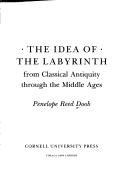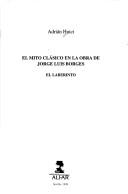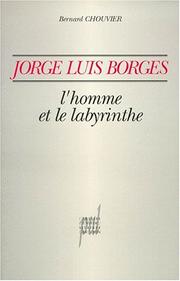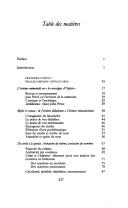| Listing 1 - 8 of 8 |
Sort by
|
Book
ISBN: 9783796540851 3796540856 Year: 2019 Publisher: Basel Schwabe Verlagsgruppe AG Schwabe Verlag
Abstract | Keywords | Export | Availability | Bookmark
 Loading...
Loading...Choose an application
- Reference Manager
- EndNote
- RefWorks (Direct export to RefWorks)
Allegory. --- Education, Humanistic. --- Labyrinths in literature. --- Satire, Medieval. --- Eberhardus,
Book
ISBN: 2246656818 Year: 2003 Publisher: Paris : Grasset,
Abstract | Keywords | Export | Availability | Bookmark
 Loading...
Loading...Choose an application
- Reference Manager
- EndNote
- RefWorks (Direct export to RefWorks)
Book
ISBN: 0801480000 1501738453 1501738461 Year: 1992 Publisher: Ithaca : Cornell University Press,
Abstract | Keywords | Export | Availability | Bookmark
 Loading...
Loading...Choose an application
- Reference Manager
- EndNote
- RefWorks (Direct export to RefWorks)
Ancient and medieval labyrinths embody paradox, according to Penelope Reed Doob. Their structure allows a double perspective-the baffling, fragmented prospect confronting the maze-treader within, and the comprehensive vision available to those without. Mazes simultaneously assert order and chaos, artistry and confusion, articulated clarity and bewildering complexity, perfected pattern and hesitant process. In this handsomely illustrated book, Doob reconstructs from a variety of literary and visual sources the idea of the labyrinth from the classical period through the Middle Ages.Doob first examines several complementary traditions of the maze topos, showing how ancient historical and geographical writings generate metaphors in which the labyrinth signifies admirable complexity, while poetic texts tend to suggest that the labyrinth is a sign of moral duplicity. She then describes two common models of the labyrinth and explores their formal implications: the unicursal model, with no false turnings, found almost universally in the visual arts; and the multicursal model, with blind alleys and dead ends, characteristic of literary texts. This paradigmatic clash between the labyrinths of art and of literature becomes a key to the metaphorical potential of the maze, as Doob's examination of a vast array of materials from the classical period through the Middle Ages suggests. She concludes with linked readings of four "labyrinths of words": Virgil's Aeneid, Boethius' Consolation of Philosophy, Dante's Divine Comedy, and Chaucer's House of Fame, each of which plays with and transforms received ideas of the labyrinth as well as reflecting and responding to aspects of the texts that influenced it.Doob not only provides fresh theoretical and historical perspectives on the labyrinth tradition, but also portrays a complex medieval aesthetic that helps us to approach structurally elaborate early works. Readers in such fields as Classical literature, Medieval Studies, Renaissance Studies, comparative literature, literary theory, art history, and intellectual history will welcome this wide-ranging and illuminating book.
Comparative literature --- anno 500-1499 --- Antiquity --- Classical literature --- Labyrinths in art --- Labyrinths in literature --- Literature, Medieval --- Littérature ancienne --- Labyrinthes dans l'art --- Labyrinthes dans la littérature --- Littérature médiévale --- History and criticism --- Histoire et critique --- Littérature ancienne --- Labyrinthes dans la littérature --- Littérature médiévale --- Labyrinths in art. --- Labyrinths in literature. --- History and criticism.

ISBN: 0801423937 1501738461 0801480000 1501738453 Year: 1990 Publisher: Ithaca : Cornell University Press,
Abstract | Keywords | Export | Availability | Bookmark
 Loading...
Loading...Choose an application
- Reference Manager
- EndNote
- RefWorks (Direct export to RefWorks)
Ancient and medieval labyrinths embody paradox, according to Penelope Reed Doob. Their structure allows a double perspective-the baffling, fragmented prospect confronting the maze-treader within, and the comprehensive vision available to those without. Mazes simultaneously assert order and chaos, artistry and confusion, articulated clarity and bewildering complexity, perfected pattern and hesitant process. In this handsomely illustrated book, Doob reconstructs from a variety of literary and visual sources the idea of the labyrinth from the classical period through the Middle Ages.Doob first examines several complementary traditions of the maze topos, showing how ancient historical and geographical writings generate metaphors in which the labyrinth signifies admirable complexity, while poetic texts tend to suggest that the labyrinth is a sign of moral duplicity. She then describes two common models of the labyrinth and explores their formal implications: the unicursal model, with no false turnings, found almost universally in the visual arts; and the multicursal model, with blind alleys and dead ends, characteristic of literary texts. This paradigmatic clash between the labyrinths of art and of literature becomes a key to the metaphorical potential of the maze, as Doob's examination of a vast array of materials from the classical period through the Middle Ages suggests. She concludes with linked readings of four "labyrinths of words": Virgil's Aeneid, Boethius' Consolation of Philosophy, Dante's Divine Comedy, and Chaucer's House of Fame, each of which plays with and transforms received ideas of the labyrinth as well as reflecting and responding to aspects of the texts that influenced it.Doob not only provides fresh theoretical and historical perspectives on the labyrinth tradition, but also portrays a complex medieval aesthetic that helps us to approach structurally elaborate early works. Readers in such fields as Classical literature, Medieval Studies, Renaissance Studies, comparative literature, literary theory, art history, and intellectual history will welcome this wide-ranging and illuminating book.
Doolhoven in de literatuur --- Labyrinten in de literatuur --- Labyrinthes dans la littérature --- Labyrinths in literature --- Classical literature --- -Labyrinths in art --- Literature, Medieval --- -European literature --- Medieval literature --- Literature, Classical --- Literature --- Literature, Ancient --- Greek literature --- Latin literature --- History and criticism --- Labyrinths in art. --- Labyrinths in literature. --- History and criticism. --- -History and criticism --- Labyrinths in art --- Literature [Medieval ]

ISBN: 8478981357 9788478981359 Year: 1998 Volume: 94 Publisher: Sevilla : Ediciones Alfar,
Abstract | Keywords | Export | Availability | Bookmark
 Loading...
Loading...Choose an application
- Reference Manager
- EndNote
- RefWorks (Direct export to RefWorks)
Mythology in literature --- Labyrinths in literature --- Mythologie dans la littérature --- Labyrinthes dans la littérature --- Borges, Jorge Luis, --- Criticism and interpretation --- Labyrinths in literature. --- Mythology in literature. --- Criticism and interpretation. --- Mythologie dans la littérature --- Labyrinthes dans la littérature --- Borges, Jorge Luis, - 1899-1986 - Criticism and interpretation --- Borges, Jorge Luis, - 1899-1986

ISBN: 2729704884 9782729704889 Year: 1994 Publisher: [Lyon] : Presses universitaires de Lyon,
Abstract | Keywords | Export | Availability | Bookmark
 Loading...
Loading...Choose an application
- Reference Manager
- EndNote
- RefWorks (Direct export to RefWorks)
Borges, Jorge Luis --- Labyrinths in literature --- Labyrinthes dans la littérature --- Borges, Jorge Luis, --- Criticism and interpretation --- Critique et interprétation --- Criticism and interpretation. --- Labyrinthes dans la littérature --- Critique et interprétation --- Borges, Jorge Luis, - 1899-1986 - Criticism and interpretation --- Borges, Jorge Luis, - 1899-1986
Book

ISBN: 9780847841998 0847841995 Year: 2013 Publisher: New York : Rizzoli,
Abstract | Keywords | Export | Availability | Bookmark
 Loading...
Loading...Choose an application
- Reference Manager
- EndNote
- RefWorks (Direct export to RefWorks)
Depuis toujours fasciné par les labyrinthes, Franco Maria Ricci nous entraîne dans une vertigineuse méditation autour de ce mythe universel. L'ouvrage explore le labyrinthe dans toutes ses dimensions, mythologiques, artistiques, littéraires ou architecturales. Une riche iconographie parcourt les représentations de labyrinthes à travers les siècles et les civilisations, dans le dessin des coquillages, le pavement des mosaïques, les enluminures médiévales, les plans d'inextricables labyrinthes végétaux...¦Un écho à l'oeuvre légendaire de Dédale, dont les tours et les détours hantent l'humanité depuis la nuit des temps.
Art --- Labyrinths in art --- Labyrinths in literature --- Maze gardens --- Labyrinthes dans l'art --- Labyrinthes dans la littérature --- Labyrinthes (Art des jardins) --- Themes, motives --- Thèmes, motifs --- Labyrinthes --- Labyrinthes de jardin --- Thèmes, motifs --- Aspect symbolique. --- Mythologie. --- Dans l'art. --- Thèmes, motifs. --- Thèmes, motifs.

ISBN: 2130498868 9782130498865 Year: 1999 Volume: *1 Publisher: Paris Presses Universitaires de France
Abstract | Keywords | Export | Availability | Bookmark
 Loading...
Loading...Choose an application
- Reference Manager
- EndNote
- RefWorks (Direct export to RefWorks)
Comparative literature
---
Thematology
---
Literature and myth
---
Literatuur en mythe
---
Littérature et mythe
---
Mythologie dans la littérature
---
Mythologie in de literatuur
---
Mythology in literature
---
Literature, Modern
---
Myth in literature.
---
Literature and myth.
---
Labyrinths in literature.
---
Littérature
---
Mythe dans la littérature
---
Labyrinthes dans la littérature
---
History and criticism.
---
Histoire et critique
---
-Myth in literature
---
#BIBC:ruil
| Listing 1 - 8 of 8 |
Sort by
|

 Search
Search Feedback
Feedback About
About Help
Help News
News